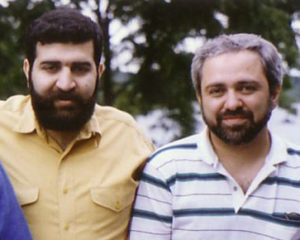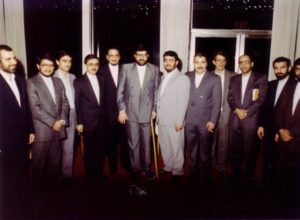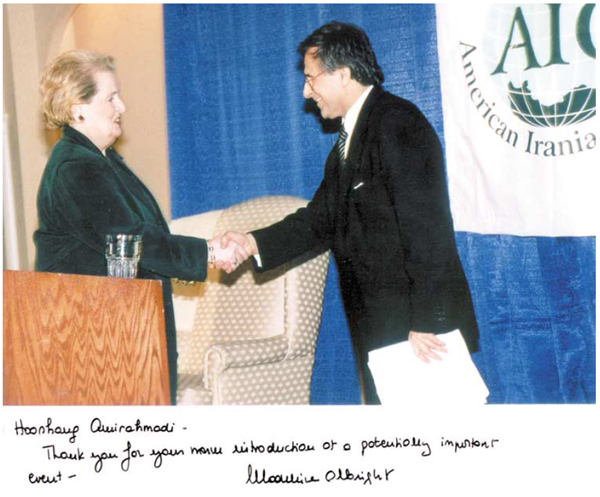Javad Zarif and Iranian regime’s web of influence in the U.S.
Sep 3rd, 2019
Hassan Dai, September 2019
Javad Zarif and Sadegh Kharrazi, architects of Iranian regime’s lobby in the US
Javad Zarif and his colleagues at Iranian mission in New York, played a key role in establishing and expanding Tehran’s web of influence in the U.S. The Implementation of sanctions on Zarif will restrict the regime’s ability to coordinate the activities of this network that exploits political divisions in the U.S, deceives public opinion and influences U.S. policies toward Iran.
—————————————-
Introduction
On July 31st, the U.S. Treasury Department placed Zarif on its sanctions list. Zarif has been one of the Iranian regime’s most important foreign policy elements during the past three decades. He represented the Islamic Republic in the United Nations in New York from 2002 to 2007. He was also very key in secret talks between the U.S. and the Iranian regime prior to the attack and occupation of Iraq in 2003, and was alongside now Iranian President Hassan Rouhani during nuclear 2003-05 negotiations with the International Atomic Energy Agency (IAEA) and three European countries.
Zarif has special relations with pro-appeasement circles in the U.S. If the sanctions on Zarif are implemented correctly and to the full extent, the regime’s ability to take advantage of political divides in the U.S., misleading public opinion and influencing U.S. policies on Iran will decrease significantly.
For a better understanding of this subject, it is necessary to review how the Iranian regime’s influence network was established in the U.S., and the role and importance of Zarif in this regard.
Creation of pro-Iran lobby in the U.S.
In 1989, Ali Akbar Hashemi Rafsanjani became president of Iran and he nominated Kamal Kharrazi as the Islamic republic’s representative to the United Nations in New York. Kamal Kharrazi took his nephew, Sadegh Kharrazi, as his main assistant. Zarif and Majid Takht Ravanchi (Iran’s current representative in the UN) were among Kharrazi’s colleagues in New York.
From right: Kamal Kharrazi Iranian Ambassador to the UN, His deputies Sadegh Kharrazi and Javad Zarif. New York, 1990
Kamal Kharrazi, Zarif and Takht Ravanchi had finished their college studies in the U.S. and were quite familiar with the U.S. political system. These individuals and their colleagues in the UN representative went on to become famous in what became known as the “New York circle” in the Iranian Foreign Ministry.
Sadegh Kharrazi and his colleagues at the Iranian mission in New York
In the early 1990s, the New York circle led by Kamal Kharrazi established the first Iranian regime lobby in the U.S. and began their cooperation with pro-appeasement entities. Sadegh Kharrazi (Kamal’s nephew) can be described as one of the main officials of this initiative. Sadegh, using two New York lawyers and with a multi-million-dollar annual budget, established connections and collaboration with various U.S. media outlets and Iran experts and, was able to hire a number of them.
Sadegh also began efforts to gain influence among Iranian-Americans, reaching no tangible results. He launched the “Aftab” TV station that was forced to close down due to its very low number of viewers.
The regime’s main ally in the U.S. were oil companies who opposedU.S. sanctions against Iran. (See the report: “The trade lobby and US policy with Iran)
In early 1990s the Iranian government signed a pre-agreement with US oil company Conoco for a project in Iran. The US oil giants considered it as a positive signal and started a campaign to soften the public opinion about the Iranian regime and allow the US administration to green light business with Iran.
This campaign was also supported by the Iranian regime and its so-called New York Circle. As a result, Hooshang Amirahmadi, a University of Rutgers professor who had previously worked with Iranian government, launched a series of “Iran-US conferences” to promote friendship between the two countries. (See pictures here and here) Amirahmadi told an Iranian newspaper that he coordinated this initiative with the Iranian ambassador to the UN and his ne[hew Sadegh Kharrazi.
Amir Ahmadi and Gary Sick’s conferences in 1993
Amirahmadi’s main partner in this campaign was Gary Sick, a former White House staffer who launched his “Gulf 2000” project in 1993 to improve US-Iran relations. Sick’s project was also funded by US oil corporations. Amirahmadi reported in his CV that he received $350.000 between 1993 to 1996 from Oil companies to organize these conferences.
Sadegh Kharrazi’s connections with the U.S. media and think tank, along with Amir Ahmadi’s conferences, can be described as the beginning of the regime’s lobby campaign in the U.S.
—————
This pro-Iran and anti-sanction campaign took on a new dimension in 1997 when the so-called reformist Mohammad Khatami became the regime’s president and he appointed Kamal Khkarrazi as his foreign minister. His nephew Sadegh Kharrazi was also appointed as the Foreign Minister’s Deputy for Education and Research. Zarif was the Deputy for International Affairs.
From right: Foreign Minister Kamal Kharrazi, President Mohammad Khatami and deputy FM Sadegh Kharazzi, 1998 Tehran
Sadegh and Zarif used the Foreign Ministry’s resources to strengthen the pro-Tehran lobby in the US. They launched a new organization in the Foreign Ministry for this very purpose that was fully supported by the government and coordinated its activities with the regime’s UN representative office in New York, establishing contacts with the U.S. media and reporters, identifying and reaching out to friendly reporters, contacting think tanks and establishing connections with their members, training Iranian experts and reporters, dispatching them to the U.S. for work in various American media outlets and institutions, establishing contact with pro-appeasement politicians in the U.S.
President Khatami’s charm offensive to soften Western attitudes toward Iran created a favorable environment for pro-Tehran lobby in the U.S. The American business interests grasped this golden opportunity and the National Foreign Trade Council (NFTC), representing large US corporations, launched its lobbying arm called USA*Engage and begun a large scale lobbying campaign to change US policy with Iran and remove sanctions.
Subsequently, Amir Ahmadi, with support from Iran’s regime and pro-appeasement circles in the U.S., especially large American oil companies, launched the American Iranian Council.
Secretary of States Madeleine Albright with AIC President Amirahamadi, her speech at AIC, March 2000, New York
Hadi Nezhad Hosseinian, a member of the New York circle and the regime’s new representative in the UN, was cooperating with this new body. AIC’s president Amirahmadi received political and financial support from Tehran and publicly called AIC a lobby organization on behalf of Iran. (Amirahmadi’s interviews with government controlled newspaper in Iran here and here) This council gathered American politicians, experts and reporters who supported friendlier policy with Iran, and as a result became a pivotal organization promoting appeasement with the Iranian regime.
Hadi Nejad Hosseinian, Iran’s ambassador to the UN at AIC Conference, December 2001, New York
In 2002, Javad Zarif was appointed as the regime’s representative in the UN. In that same year, a new pro-regime lobby organization, the National Iranian American Council (NIAC), was launched by Trita Parsi. NIAC began its collaboration with Zarif from the early days. NIAC replaced Amir Ahmadi’s AIC as the regime’s most important lobby arm in the US. (See NIAC Fact Book)

Iranian President Mahmoud Ahmadinejad (L) confers with Javad Zarif (R), Iran’s United Nations ambassador, during the United Nations General Assembly 19 September 2006 at UN headquarters in New York. AFP PHOTO/Stan HONDA
During his tenure in the UN, Zarif expanded the regime’s web of influence in the U.S. and played a key role in several important projects on behalf of the regime. In 2005, after Mahmoud Ahmadinejad became president and in early 2006, Iran resumed its nuclear activities and the hostilities between Iran and the West increased. As a result, the US anti-war movement feared a new war in the region and voiced its concern and criticized US animosity toward Iran. The Iranian regime launched an ambitious plan to connect with American anti-war groups, recruit amongst them and use their social network in a grassroots lobby to influence public opinion and prevent tougher policies against Iran. Zarif and his successor at the Iranian mission Mohamad Khazaee worked closely with NIAC to carry out this campaign. (See report: “Relation and cooperation between Iranian regime and American anti-war groups”)
President Mahmoud Ahmadinejad and Iranian Ambassador to the UN, Mohammad Khazaee’s meeting with the leader of US anti-war groups, New York, September 2008
Esfandiar Rahim Mashaei, vice president during Mahmoud Ahmadinejad’s tenure, was the man in charge of this initiative. Under this framework, hundreds of officials linked to U.S. anti-war groups were provided free travel for Tehran to garner their support and, upon their return to the U.S., lobby in favor of the Iranian regime alongside NIAC.
As the Iranian ambassador to the UN between 2002 and 2007 Zarif was able to establish close relations with Congress members, political figures and think tanks that opposed George Bush’s policy toward Iran. These relations accompanied by a large-scale lobby campaign weakened the White House pressure against Iran.
Javad Zarif with Senator Chuck Hagel and AIC President H. Amirahmadi, New York, March 2007
Years later in 2013 when Zarif was appointed as Foreign Minister, he made a speech to the Iranian parliament bragged about these contacts and his successful campaign to exploit U.S. political divisions on behalf of Iranian regime: “I had the approval of the regime’s highest authorities and established contacts with anti-Bush politicians within the U.S. to attempt to cause a division amongst the decision makers and neutralize the White House’s bellicose policy toward Iran.” Zarif’s main partner in this campaign was NIAC and its President Trita Parsi. (See report: Trita Parsi and NIAC’s relation with Iranian ambassador Zarif
Iranian regime’s Foreign Minister
In 2010, after the nuclear negotiations between iran and the P5+1 countries failed, the U.S. and Europe imposed a series of crippling sanctions targeting Tehran. In 2012, with Khamenei’s approval and in search for an exit from the crisis, the Iranian regime began secret talks with the U.S. in Oman.
One year later Hassan Rouhani became president and he appointed Zarif as his Foreign Minister. One of the regime’s main objectives in selecting Rouhani and Zarif was to present a softer image of the regime and maximize the use of their lobby/influence network in the U.S. for the sake of gaining the utmost concessions in the nuclear negotiations.
Obama was very fond of engaging the Iranian regime. As a result, the second term of Obama’s presidency could be considered the golden era for the regime’s lobby in the U.S. In this period, NIAC, led by Parsi, became a White House partner. The official White House website shows that from 2013 to 2015, Parsi had visited the White House 33 times for discussions and negotiations. (See Video Documentary: Iran lobby under Obama, from pressure group to White House partner”)
In fact, the Iranian regime, with support from its lobby in the U.S., was able to influence U.S. policy not only to reach some of its objectives in the nuclear negotiations, Tehran was also able to prevent Washington from confronting its regional policies. As a result, the mullahs easily expanded their military influence and presence across the Middle East in unprecedented fashion.
In 2018, under a decision by U.S. President Donald Trump, Washington pulled out of the JCPOA and imposed strong economic sanctions against the regime. Currently, the mullahs’ regime is facing incurable economic bankruptcy and growing dissent. The popular movement is threatening the entire mullahs’ regime as a fire simmering under the ashes.
In these circumstances, Tehran is using all its assets to overcome this crisis, including Zarif’s connections with pro-appeasement circles in the U.S. and pro-Tehran lobby network. They aim to confront the U.S.’ maximum pressure policy and once again gain some concessions by the US in possible future negotiations with a new U.S. president or even the Trump administration.
Zarif’s repetitive visits to the U.S. and his open collaboration with the pro-appeasement circles to counter Trump’s policies have convinced the U.S. administration that through sanctions they will be able to limit Zarif’s maneuverability and freedom of action in the U.S.
The annual UN General Assembly in September in New York, and a possible visit by Rouhani and Zarif, will make it clear if the U.S. government is serious about sanctioning Zarif and limiting the Iranian regime’s Foreign Ministry connections with the U.S.-based pro-appeasement lobby.










هیچ نظری موجود نیست:
ارسال یک نظر